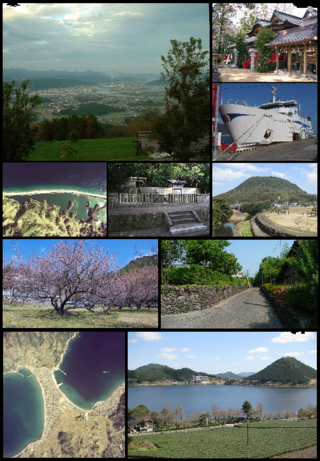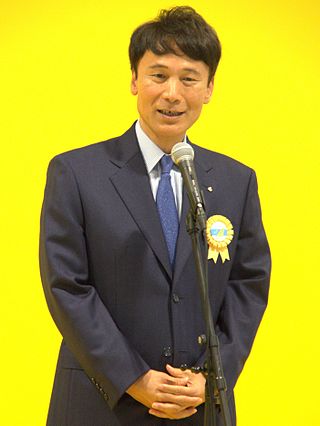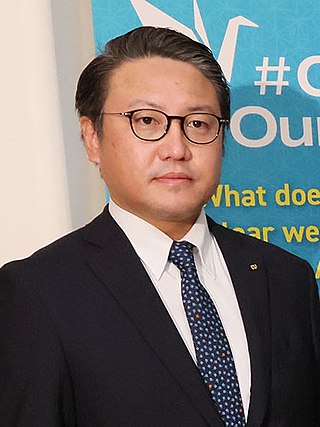
Satsumasendai is a city located in Kagoshima Prefecture, Japan. As of 1 July 2024, the city had an estimated population of 90,918 in 46610 households, and a population density of 130 persons per km2. The total area of the city is 682.92 km2 (263.68 sq mi).

Hiroshi Moriyama is a Japanese politician who has served as Secretary-General of the Liberal Democratic Party since 2024. He previously served as Minister of Agriculture, Forestry and Fisheries from 2015 to 2016. He was a member of the House of Councillors from 1998 to 2004 and has been a member of the House of Representatives since 2004.

Kenta Izumi is a Japanese politician who served as leader of the Constitutional Democratic Party of Japan (CDP) from 2021 to 2024. He is also a member of the House of Representatives in the National Diet, currently for the Kyoto 3rd district. He was first elected in 2000 under the Democratic Party of Japan. He served as Parliamentary Vice-Minister of the Cabinet Office from 2009 to 2010. After that, he served as chairman of the National Diet Measures Committee and Political Affairs Research Chairman of the Kibō no Tō, the Democratic Party for the People, and the Constitutional Democratic Party of Japan.

Yukio Edano is a Japanese politician who served as the leader of the Constitutional Democratic Party of Japan from its formation in 2017 until 2021.
Yūichirō Itō is a Japanese politician and former governor of Kagoshima Prefecture in Japan. A native of Izumi, Kagoshima and graduate of the University of Tokyo with the Bachelor of Laws in June 1971, he had worked at the Ministry of Home Affairs since 1972 before elected governor.
Events in the year 2012 in Japan.

The 2014 Tokyo gubernatorial election took place on February 9, 2014 to replace outgoing Governor Naoki Inose, who resigned effective December 24, 2013. Yōichi Masuzoe was declared the winner in exit polling, with a substantial lead over the fifteen other candidates. His final tally was 2,112,979 votes (42.86%), with his two closest competitors Morihiro Hosokawa and Kenji Utsunomiya failing to break the 20% mark. Total turnout was 4,930,251 (46.14%), significantly lower than the 62.6% turnout in the 2012 election.

Kagoshima 2nd district is a single-member electoral district of the House of Representatives, the lower house of the National Diet of Japan. The district covers two different parts of Kagoshima Prefecture. On the main island of Kyushu, it covers most of the Satsuma Peninsula; this includes the cities of Makurazaki, Ibusuki, Minamisatsuma, and Minamikyūshū, as well as the former municipalities Taniyama City and Kiire Town, which are now a part of the capital Kagoshima City. The district also includes Ōshima Subprefecture, which covers the Amami Islands more than 300 kilometres to the south, which includes the city of Amami. In 2021, the district had 337,660 eligible voters.

House of Councillors elections were held in Japan on Sunday 10 July 2016 to elect 121 of the 242 members of the upper house of the National Diet, for a term of six years. As a result of the election, the Liberal Democratic Party–Komeito coalition gained ten seats for a total of 145, the largest coalition achieved since the size of the house was set at 242 seats.

Sairi Ito is a Japanese actress.
The following lists events that happened during 2016 in Japan.

Satoshi Mitazono is a Japanese politician and journalist who is the former governor of Kagoshima Prefecture. He defeated the incumbent Yūichirō Itō at an election held on 10 July 2016.
The 2018 Niigata gubernatorial election was held on 10 June 2018 to elect the next governor of Niigata. Incumbent Governor Ryuichi Yoneyama resigned on 18 April 2018 in the wake of a sex scandal. This was also the first gubernatorial election in Niigata since the voting age was lowered to 18.

Yuria Katō is a Japanese women's professional shogi player ranked 2-dan.

The 2022 Nagasaki gubernatorial election was a gubernatorial election held on 20 February 2022 to elect the next governor of Nagasaki, a prefecture of Japan in the north-west of Kyushu.

Kimi Onoda is a Japanese politician of the Liberal Democratic Party. She served as Parliamentary Vice-Minister of Defense from 2022 to 2023 and is a member of the House of Councillors representing Okayama. She previously served as Parliamentary Vice-Minister of Justice from 2020 to 2021 under the Suga Cabinet.
On April 28, 2024, by-elections in Japan were held in order to fill vacancies in the National Diet of Japan. In the October 27 slot, there will be at least one national by-election, for the Iwate senate seat in the 2022 class after incumbent Megumi Hirose (LDP→independent) has resigned.

Makoto Yamashita is a Japanese politician and the current governor of Nara Prefecture in Japan.

The 2024 Hyōgo gubernatorial election took place on 17 November 2024 to elect the governor of Hyōgo, Japan. Incumbent Motohiko Saitō was re-elected for a second term.















